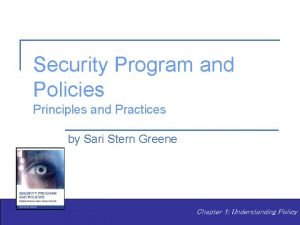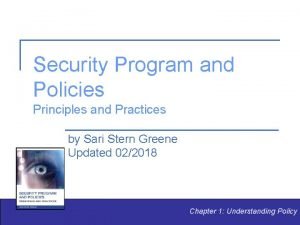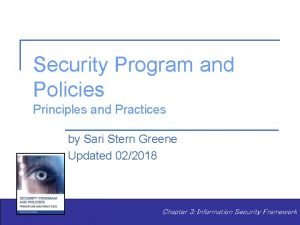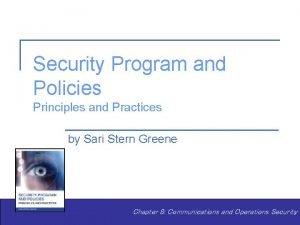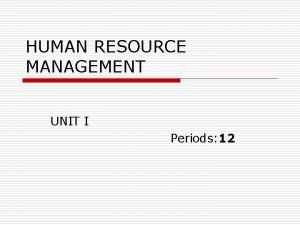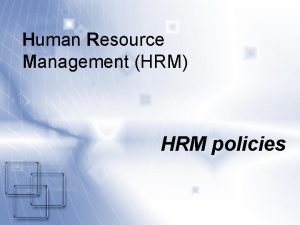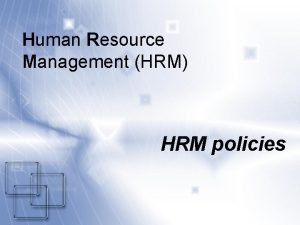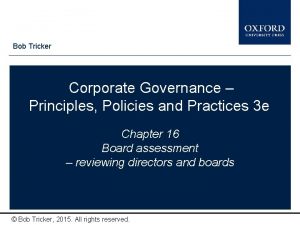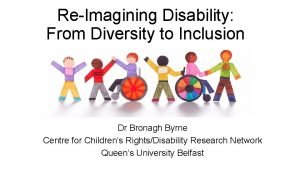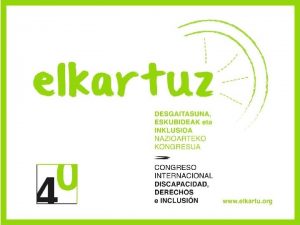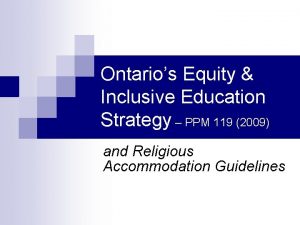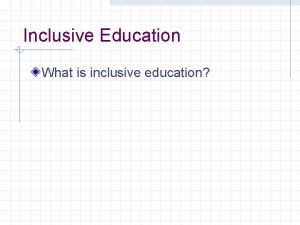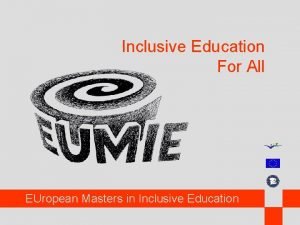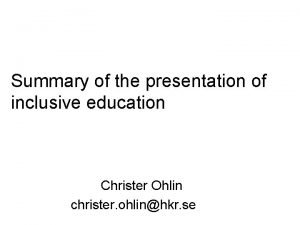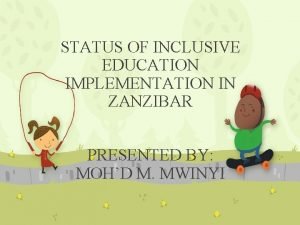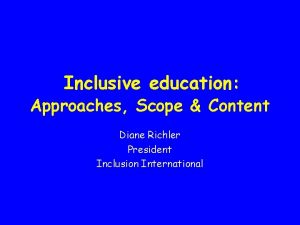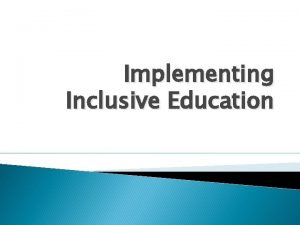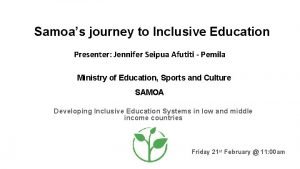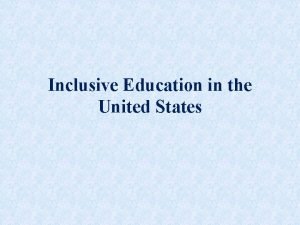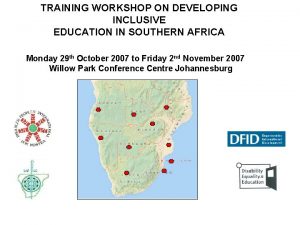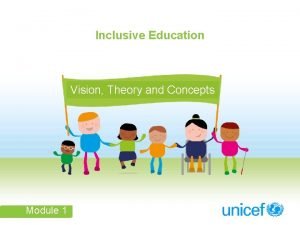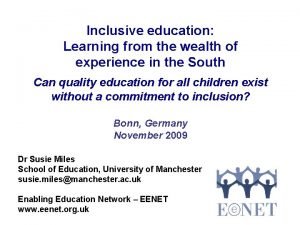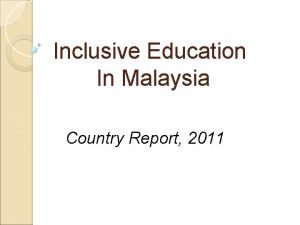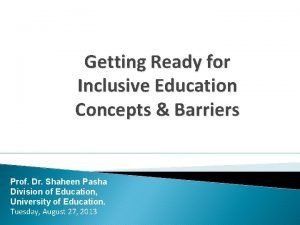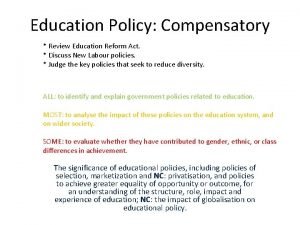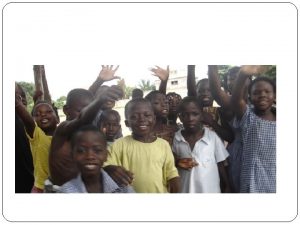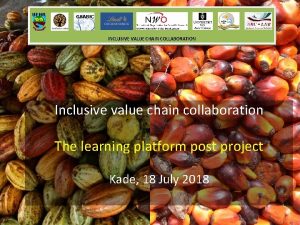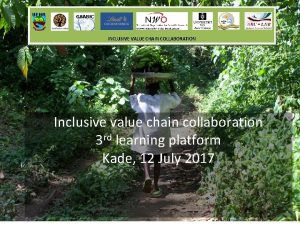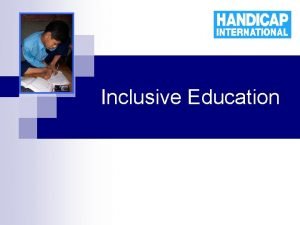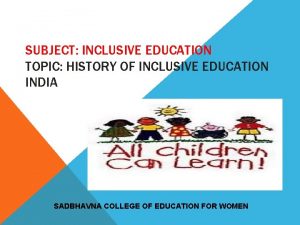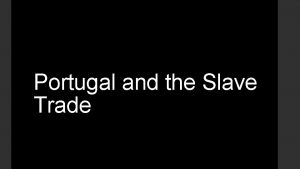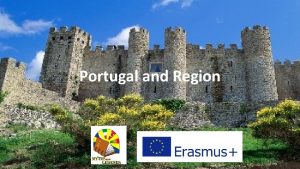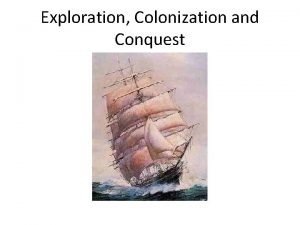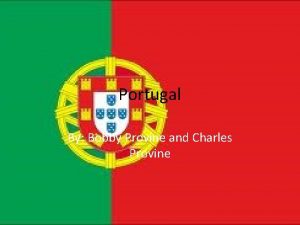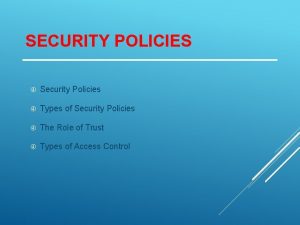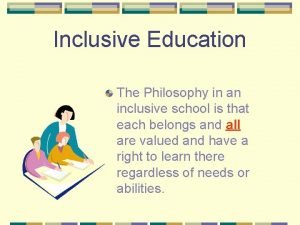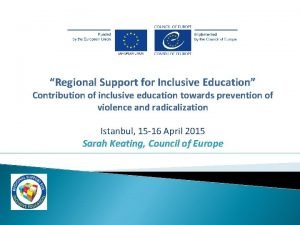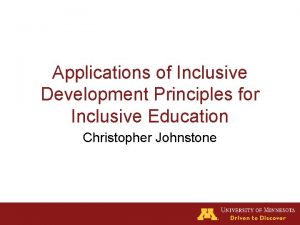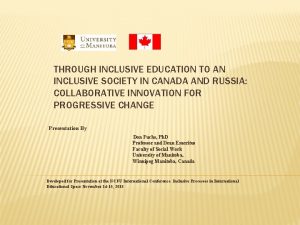INCLUSIVE EDUCATION POLICIES AND PRACTICES IN PORTUGAL The





























- Slides: 29

INCLUSIVE EDUCATION POLICIES AND PRACTICES IN PORTUGAL: The implementation of Decree-Law No 3/ 2008 Mónica Silveira-Maia & Manuela Sanches-Ferreira Special Education Department School of Education, Porto Polytechnic Institute SENnet Meeting March, 2014

Overview ¢ Inclusive education policies – strengthening the connection between practices and the state of the art ¢ Portuguese legislation: the Decree-Law No. 3/ 2008 ¢ Lessons Learnt from Decree-law No. 3/ 2008 implementation

Development and implementation of inclusive education policies Philosophy/The ories Legislation Practices/ Implementation Adapted from Steer (2009)

Philosophy and Theory HUMAN RIGHTS AND VALUES KNOWLEDGE 3 rd generation of disability understanding Promoting the right and a culture of diversity Respecting the diversity of needs Needs – gap between students’ capacities and contextual demands The right to participate – accessing supports Support – resources or strategies that promote personenvironment fitness INCLUSION A gestalt between rights, values and knowledge

International trends Practices - Implementation Finding better ways of responding to diversity PHILOSOPHY AND THEORY HUMAN RIGHTS AND VALUES A culture of diversity KNOWLEDGE Focus on personenvironment interaction Respecting the diversity of needs Needs – gap between students’ capacities and contextual demands The right to participate – accessing supports Support – resources or strategies that promote personenvironment fitness PRACTICESIMPLEMENTATION A process of environmental habilitation Person-centred planning; participation-oriented goals Participation as a result from personenvironmental interaction

International Classification of Functioning, Disability and Health (ICF -CY): a person-environment fit approach in education Neutral Language Multidimensional/ Interactional Approach Universal Language Health Condition (disorder/ disease) Body functions and structures Activities Participation (full to limitations) (full to restrictions) (intact to impairment) Environmental factors (barriers- Personal factors World Health Organization (2001; 2007)

Development and implementation of inclusive education policies Philosophy/Theories HUMAN RIGHTS AND VALUES KNOWLEDGE Legislation Practices/ Implementation WHO is eligible? HOW to assess? Person-centred planning; participationoriented goals WHAT resources, methods/strategies? WHOM? Participation as a result from personenvironmental interaction

’the way in which a problem is Development and implementation described says a great deal about of inclusive education policies how it will be resolved’ (Kirp, 1982). Philosophy/Theories HUMAN RIGHTS AND VALUES KNOWLEDGE Legislation Practices/ Implementation WHO is eligible? How Portuguese HOW to assess? Person-centred planning; participationoriented goals WHOM? Participation as a result from personenvironmental interaction Legislation prompted the connection between practices the state of WHATand resources, the art? methods/strategies?

Portuguese Legislation Strengthening the connection between practices and the state of the art 12 years of compulsory education Law # 85/2009 Decree-Law # 3/2008 Decree-Law # 281/2009 Specialized Supports (Pre -school to Secondary education) National System for Early Childhood Intervention Ordinance # 275 -A/2012 Supporting the postschool transition

Portuguese Legislation – Decree-Law No. 3/ 2008 Strengthening the connection between practices and the state of the art Promotion of Inclusive School Partnerships The educative responses in IEP belong to the whole plan of schools Cap. I Goals, and guiding principals Goals, framework guiding principals Cap. II Referral and Assessment procedures Cap. III & IV Individualised Education Plan (IEP) and Individualized Transition Plan (ITP) and Educational measures Cap. V Specific Modalities of Education Cap. VI Cooperation relationships with other institutions and services To respond to the diversity of characteristics and needs of all students (Preamble) Biopsychosocial model and functioning profile using ICF as referral Interdisciplinary Teams 10

Portuguese Legislation – Decree-Law No. 3/ 2008 Strengthening the connection between practices and the state of the art Promotion of Inclusive School Partnerships The educative responses in IEP belong to the whole plan of schools Cap. II Goals, and guiding principals Goals, framework guiding principals Cap. II II Referral and Assessment procedures Referral Assessment procedures How isand the process of referral and assessment? Cap. III & & IV IV Individualised Education Planand (IEP) and Individualised Education Plan (IEP) Individualized Who is eligible for the special education Individualized Transition Plan (ITP) and Educational measures services – i. e. , for the designing of an IEP? Educational measures Cap. V Specific Modalities of Education Cap. VI Cooperation relationships with other institutions and services To respond to the diversity of characteristics and needs of all students (Preamble) Biopsychosocial model and functioning profile using ICF as referral Interdisciplinary Teams 11

How is the process of referral and assessment? The use of the ICF-CY framework to guide the assessment process 1. Referral I. REFERRAL FORM Referral is made to school’s administrators in the area of residence ever it is suspected the existence of permanent educational needs 2. Assessment The department of special education and technical-pedagogical services that support students analyze the available information and decide on the need for a specialized assessment by reference to the ICF-CY 3. Student does not need a specialized assessment 5. The student does not need educational responses from special education services 7. The department of special education and technical-pedagogical services that support students guide student to the available supports by school, provided in Education Project 4. Student needs a specialized assessment, by reference to the ICF-CY 6. The student needs educational responses from special education services 8. Development of the IEP based on data in the technical-pedagogical report, resulting from the specialized assessment previously conducted by reference to the ICF-CY II. PLAN OF A SPECIALIZED ASSESSMENT III. TECHNICALPEDAGOGICAL REPORT IV. INDIVIDUALIZED EDUCATION PROGRAM Adapted from Capucha et al. , 2008

WHO is eligible for special education services? Replacement of diagnosis by functioning profiles The target group for special education services was defined as students with: "significant limitations in terms of activity and participation in one or more areas of life, due to structural and functional permanent changes resulting in continued difficulties in communication, learning, mobility, autonomy, interpersonal relationships and social participation" (Paragraph 1 of Article 1 st, Chapter I).

WHO is eligible for special education services? Replacement of diagnosis by functioning profiles From a one-dimensional view Towards a multidimensional view “. . . Diagnostic: Malformation Syndrome (hc)” “. . . Child with macrocephaly (hc), with big hand feet (s 750), with dolichocephalic cranium (s 110), high forehead. . . Evidence of Sotos Syndrome (hc)” “. . . Strabismus (b 2152), nystagmus (b 2152), hypotonia in flexor muscles of the neck (b 735)” Through the use of observation (d 110. 0), Daniel begins to imitate adults’ actions – showing, however, severe limitations on reproducing the gestures (d 130. 3). These difficulties are motivated by impairments on sequencing complex movements (b 176. 3 d 130. 3). When actions are segmented and when adults shapes his movements, he imitates simple gestures (e 330+2 d 130. 3_2). Sanches-Ferreira, 2013 – Communication presented at 20 th April, ESE Bragança

Portuguese Legislation – Decree-Law No. 3/ 2008 Strengthening the connection between practices and the state of the art Promotion of Inclusive School Partnerships The educative responses in IEP belong to the whole plan of schools Cap. I Goals, framework and guiding principals Cap. II Referral and Assessment procedures Cap. III & IV Individualised Education Plan (IEP) and Individualized Transition Plan (ITP) and By whom? Educational measures Cap. V Specific Modalities of Education Cap. VI Final dispositions Biopsychosocial model and functioning profile using ICF as referral What resources and strategies? Interdisciplinary Teams 15

WHAT resources and strategies? And by WHOM? Strengthening mainstream contexts Respond to the diversity of characteristics and needs of all students Inclusive Resource Centers Individual Transition Plans Comunity School Regular education teacher as coordinator of the Individualized Education Plan (IEP) Student and Famíly Regular schools of reference in the areas of low vision and blindness and deafness, and specialized units to support the education of students with autism and multiple disabilities Parents right and duty of involvement in all process of decision-making and IEP design Sanches-Ferreira, 2013 – Communication presented at 20 th April, ESE Bragança

Lessons Learnt from Decree-law No. 3/ 2008 implementation - Did the use of the ICF-CY promote a holistic view of students? (project developed between Jan 2009 -Dec 2010. Coordinator: Manuela Sanches-Ferreira; Consultant: Rune Simeonsson)

Lessons Learnt from Decree-Law implementation Did the use of the ICF-CY promote a holistic view of students? The profiles (25 codes) ENVIRONMENTA L FACTORS 5 codes In the functionality profile component Activities and Participation is considered as easy to assess. BODY FUNCTIONS 7 codes 19% 28% ACTIVITIES AND PARTICIPATION 13 codes 53% The professionals’ opinion The ICF enabled a better understanding of students and their needs; Professionals considered that the focus on functioning and on Environmental Factors is present in the profiles. 18

Lessons Learnt from Decree-Law implementation Did the use of the ICF-CY promote a holistic view of students? The profiles (25 codes) ENVIRONMENTA L FACTORS 5 codes BODY FUNCTIONS 7 codes The professionals’ opinion In the functionality profile component Activities and Participation is considered as easy to assess. 19% The ICF enabled a better understanding The biopsychosocial model, 28% operationalized by ICF, enabled a of students and their needs; greater understanding of students and their needs ACTIVITIES AND PARTICIPATION 13 codes 53% Professionals considered that the focus on functioning and on Environmental Factors is present in the profiles. 19

Lessons Learnt from Decree-Law implementation Did the use of the ICF-CY promote a holistic view of students? Environmental Factors less represented and described mainly as facilitators ENVIRONMENTAL FACTORS 5 codes BODY FUNCTIONS 7 codes 19% 28% ACTIVITIES AND PARTICIPATION 13 codes 53% Static and linear connection between participation restrictions and BF impairments Functional contents less represented on students with ISC (high individualized curriculum) profiles (e. g. , mobility, self-care, domestic life, major life areas)

Lessons Learnt from Decree-Law implementation Did the use of the ICF-CY promote a holistic view of students? Environmental Factors less represented and described mainly as facilitators ENVIRONMENTAL FACTORS 5 codes 19% BODY FUNCTIONS 7 codes The Static and linear connection between functioning are still not fully participation restrictions and BF impairments 28% profiles informing the IEP design ACTIVITIES AND PARTICIPATION 13 codes 53% Functional contents less represented on students with ISC (high individualized curriculum) profiles (e. g. , mobility, self-care, domestic life, major life areas)

Lessons Learnt from Decree-law No. 3/ 2008 implementation - How the use of the ICF-CY has been supporting the eligibility decision-making based on students’ functioning profiles?

Lessons Learnt from Decree-Law implementation How the use of the ICF-CY has been supporting the eligibility decision-making based on students’ functioning profiles? No. Codes Level of severity 18 12 3 6 12 2 6 FC AP FA 18 FC 6 2 5 0 FC 18 AP FA 8 6 5 AP 2 2. 1 FC AP FA 1. 8 1 2. 1 FA 2. 4 1. 9 2 Eligible with ISC 1 (t(154)=-2. 75, p=. 007) 0 0 FC AP FA Eligible without ISC 0 3 16 Non Eligible (t(185)=5. 7, p<. 001) 0 3 11 6 12 1. 2 1 1 0 12 0. 9 4 FC AP FA

Lessons Learnt from Decree-Law implementation How the use of the ICF-CY has been supporting the eligibility decision-making based on students’ functioning profiles? No. Codes Level of severity 18 12 3 6 12 2 6 FC AP FA 18 FC 6 AP 2 2. 1 FC AP FA 1. 8 The ICF-CY allowed the gradation of functionality 5 2 1 0 FC 18 AP FA 8 6 5 2. 1 FA 2. 4 1. 9 2 Eligible with ISC 1 (t(154)=-2. 75, p=. 007) 0 0 FC AP FA Eligible without ISC 0 3 16 Non Eligible (t(185)=5. 7, p<. 001) 0 3 11 6 12 1. 2 1 1 0 12 0. 9 4 FC AP FA

Lessons Learnt from Decree-law No. 3/ 2008 implementation - Did the decree law promote/ reinforce the inclusive school?

Lessons Learnt from Decree-Law implementation Did the decree law promote/ reinforce the inclusive school? Comunity School Student and Famíly Incipient ITPs implementation Barriers: difficulties on developing collaboration and partnerships mechanisms Greater involvement of regular education teacher. Barriers: difficulties managing schedules, lack of knowledge Regular schools of reference and specialized units were important supports for students’ educational success Greater involvement of parents on the process There is still room to increase their participation Sanches-Ferreira, 2013 – Communication presented at 20 th April, ESE Bragança

Lessons Learnt from Decree-Law implementation Did the decree law promote/ reinforce the inclusive school? Comunity School Incipient ITPs implementation Barriers: difficulties on developing collaboration and partnerships mechanisms Greater involvement of regular education teacher. Main conclusions: Barriers: difficulties managing schedules, lack of knowledge The DL promoted the inclusive process, namely enhancing the time Student and the engagement on the classroom activities by the students with Regular schools of reference and specialized units and were important supports for students’ educational SEN and that the quality of educational measures Famíly success Greater involvement of parents on the process There is still room to increase their participation Sanches-Ferreira, 2013 – Communication presented at 20 th April, ESE Bragança

Development and implementation of inclusive education policies Philosophy/Theories Reinforcing human rights and values; sustaining a personenvironment fit approach Legislation Promoting a constellation of services towards a fusion between regular and special education Practices/ Implementation Making the inclusion a routine - improving education efficiency and students’ experiences

External Evaluation of the Decree-Law implementation REFERENCES Final Report: http: //www. dgidc. minedu. pt/educacaoespecial/data/ensinoespecial/estudo_simeonsson. pdf Executive Summary: http: //www. dgidc. minedu. pt/educacaoespecial/data/ensinoespecial/estudo_simeonsson_sumario. pdf Related Articles: • Sanches-Ferreira M, Simeonsson R, Silveira-Maia M, Alves S, Pinheiro S, Tavares A. Portugal’s special education law: implementing the International Classification of Functioning, Disability and Health in policy and practice. 2013. Disability and Rehabilitation, 35(9 -10): 868– 873 • Sanches-Ferreira M, Lopes-dos Santos P, Alves S, Santos M, Silveira-Maia M. How individualised are the Individualised Education Programmes (IEPs): an analysis of the contents and quality of the IEPs goals. 2013. European Journal of Special Education Needs. • Sanches-Ferreira M, Silveira-Maia M, Alves S. The use of the International Classification of Functioning, Disability and Health, version for Children and Youth (ICF-CY), in Portuguese special education assessment and eligibility procedures: the professionals' perceptions (accepted). 2014. European Journal of Special Education Needs.
 Conclusion on inclusive education
Conclusion on inclusive education Security program and policies principles and practices
Security program and policies principles and practices Security program and policies principles and practices
Security program and policies principles and practices Security program and policies principles and practices
Security program and policies principles and practices Security program and policies principles and practices
Security program and policies principles and practices Security program and policies principles and practices
Security program and policies principles and practices Hr policy meaning
Hr policy meaning Hr policies and practices
Hr policies and practices Human resource policies
Human resource policies Tricker corporate governance
Tricker corporate governance Reimigining disability and inclusive education
Reimigining disability and inclusive education Reimigining disability and inclusive education
Reimigining disability and inclusive education Ontario's equity and inclusive education strategy
Ontario's equity and inclusive education strategy Inclusive education and community partnership
Inclusive education and community partnership Aims and objectives of inclusive education
Aims and objectives of inclusive education Miguel lopez melero
Miguel lopez melero Conclusion for inclusive education
Conclusion for inclusive education Achievement of inclusive education in zanzibar
Achievement of inclusive education in zanzibar Diane richler
Diane richler Unesco inclusive education
Unesco inclusive education Inclusive education policy
Inclusive education policy What is this photo
What is this photo Objectives of inclusive education
Objectives of inclusive education Objectives of inclusive education
Objectives of inclusive education Inclusive education definition
Inclusive education definition Disadvantages of inclusive education slideshare
Disadvantages of inclusive education slideshare Acrostic poems rules
Acrostic poems rules Barriers to inclusive education
Barriers to inclusive education Compensatory education policies
Compensatory education policies Recruitment selection and induction policies and procedures
Recruitment selection and induction policies and procedures


